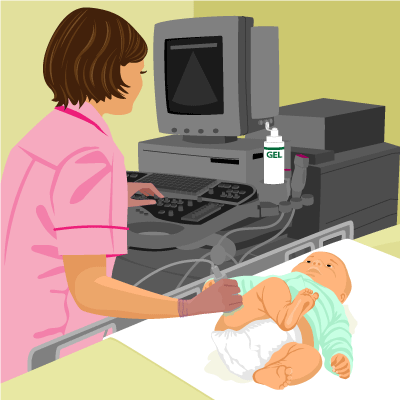Ultrasound: Infant Hip
What Is an Ultrasound?
An ultrasound scan is a medical test that uses high-frequency sound waves to create live images from the inside the body. Also called a sonogram or sonography, ultrasounds let doctors see the body’s soft tissues, which X-rays can’t do.
Doctors order ultrasounds for many reasons, such as to look for the causes of pain, swelling, and infection. Ultrasound scans are safe and painless.
What Is a Hip Ultrasound?
A hip ultrasound uses sound waves to make images of the hip.
An ultrasound machine sends sound waves into the hip area, and images are recorded on a computer. The black-and-white images show the internal structures of the hip, including the ball-shaped top of the thighbone (femoral head) and its socket (acetabulum) in the pelvic bone.
The scan can be done on babies up to about 6 months of age.
Why Are Hip Ultrasounds Done?
Doctors order a hip ultrasound when they suspect a problem called developmental dysplasia of the hip (DDH). This problem can happen before, during, or weeks to months after birth.
Normally, the femoral head rests comfortably in its socket. In babies with DDH, it moves back and forth within the socket. In more serious cases, it may move out of the socket, but can be put back into place with pressure — this is called dislocation. In the most severe cases, it may not be possible to put the femoral head into the socket at all.
A hip ultrasound might be done for a baby if the doctor finds a hip problem, such as:
- At birth, the baby can’t move the thigh outward at the hip as far as normally possible.
- The doctor hears or feels a hip "click" when moving the infant's thigh outward during a routine checkup.
- The baby’s legs have differences in their lengths or appearances.
You'll be asked to partly undress your baby and take off their diaper for the test. Your baby will be placed on a table on their back or side. The scan usually takes about 20 minutes. Usually, both hips are scanned for comparison.
It might help to feed your baby just before the ultrasound to make your little one more relaxed. During the test, comfort your baby with a calm and soothing voice or sing a favorite song. Make sure to stand where your baby can see your face.
What if I Have Questions?
If you have questions about the hip ultrasound or what the test results mean, talk to your doctor.

Reviewed by: Larissa Hirsch, MD
Date Reviewed: Jan 15, 2022
















